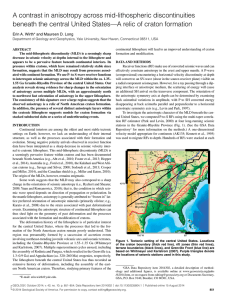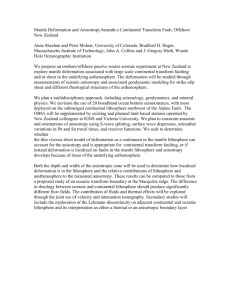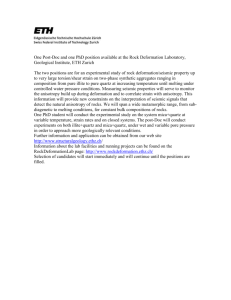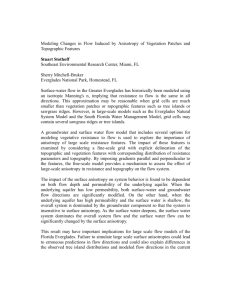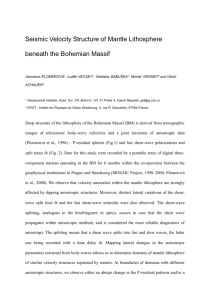Wirth_G35804 1st pages
advertisement
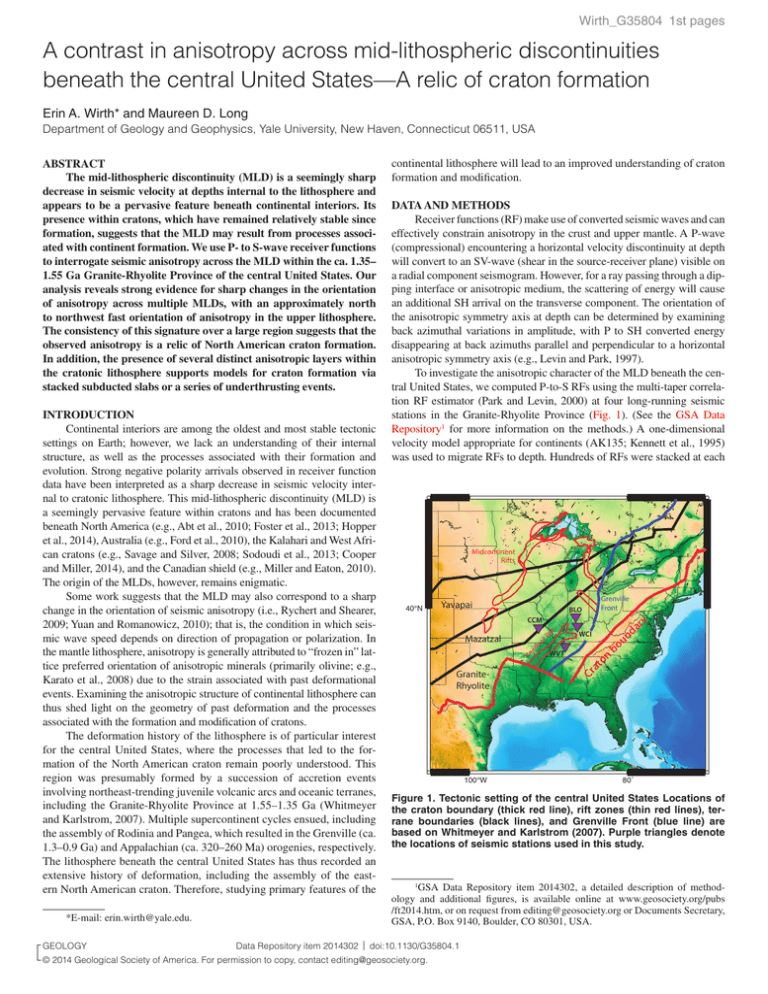
Wirth_G35804 1st pages A contrast in anisotropy across mid-lithospheric discontinuities beneath the central United States—A relic of craton formation Erin A. Wirth* and Maureen D. Long Department of Geology and Geophysics, Yale University, New Haven, Connecticut 06511, USA *E-mail: erin.wirth@yale.edu. DATA AND METHODS Receiver functions (RF) make use of converted seismic waves and can effectively constrain anisotropy in the crust and upper mantle. A P-wave (compressional) encountering a horizontal velocity discontinuity at depth will convert to an SV-wave (shear in the source-receiver plane) visible on a radial component seismogram. However, for a ray passing through a dipping interface or anisotropic medium, the scattering of energy will cause an additional SH arrival on the transverse component. The orientation of the anisotropic symmetry axis at depth can be determined by examining back azimuthal variations in amplitude, with P to SH converted energy disappearing at back azimuths parallel and perpendicular to a horizontal anisotropic symmetry axis (e.g., Levin and Park, 1997). To investigate the anisotropic character of the MLD beneath the central United States, we computed P-to-S RFs using the multi-taper correlation RF estimator (Park and Levin, 2000) at four long-running seismic stations in the Granite-Rhyolite Province (Fig. 1). (See the GSA Data Repository1 for more information on the methods.) A one-dimensional velocity model appropriate for continents (AK135; Kennett et al., 1995) was used to migrate RFs to depth. Hundreds of RFs were stacked at each Midcontinent Rifts Yavapai BLO Grenville Front GraniteRhyolite WVT WCI Cr at on tR Mazatzal ift CCM bo un da ry 40°N el fo o INTRODUCTION Continental interiors are among the oldest and most stable tectonic settings on Earth; however, we lack an understanding of their internal structure, as well as the processes associated with their formation and evolution. Strong negative polarity arrivals observed in receiver function data have been interpreted as a sharp decrease in seismic velocity internal to cratonic lithosphere. This mid-lithospheric discontinuity (MLD) is a seemingly pervasive feature within cratons and has been documented beneath North America (e.g., Abt et al., 2010; Foster et al., 2013; Hopper et al., 2014), Australia (e.g., Ford et al., 2010), the Kalahari and West African cratons (e.g., Savage and Silver, 2008; Sodoudi et al., 2013; Cooper and Miller, 2014), and the Canadian shield (e.g., Miller and Eaton, 2010). The origin of the MLDs, however, remains enigmatic. Some work suggests that the MLD may also correspond to a sharp change in the orientation of seismic anisotropy (i.e., Rychert and Shearer, 2009; Yuan and Romanowicz, 2010); that is, the condition in which seismic wave speed depends on direction of propagation or polarization. In the mantle lithosphere, anisotropy is generally attributed to “frozen in” lattice preferred orientation of anisotropic minerals (primarily olivine; e.g., Karato et al., 2008) due to the strain associated with past deformational events. Examining the anisotropic structure of continental lithosphere can thus shed light on the geometry of past deformation and the processes associated with the formation and modification of cratons. The deformation history of the lithosphere is of particular interest for the central United States, where the processes that led to the formation of the North American craton remain poorly understood. This region was presumably formed by a succession of accretion events involving northeast-trending juvenile volcanic arcs and oceanic terranes, including the Granite-Rhyolite Province at 1.55–1.35 Ga (Whitmeyer and Karlstrom, 2007). Multiple supercontinent cycles ensued, including the assembly of Rodinia and Pangea, which resulted in the Grenville (ca. 1.3–0.9 Ga) and Appalachian (ca. 320–260 Ma) orogenies, respectively. The lithosphere beneath the central United States has thus recorded an extensive history of deformation, including the assembly of the eastern North American craton. Therefore, studying primary features of the continental lithosphere will lead to an improved understanding of craton formation and modification. Re ABSTRACT The mid-lithospheric discontinuity (MLD) is a seemingly sharp decrease in seismic velocity at depths internal to the lithosphere and appears to be a pervasive feature beneath continental interiors. Its presence within cratons, which have remained relatively stable since formation, suggests that the MLD may result from processes associated with continent formation. We use P- to S-wave receiver functions to interrogate seismic anisotropy across the MLD within the ca. 1.35– 1.55 Ga Granite-Rhyolite Province of the central United States. Our analysis reveals strong evidence for sharp changes in the orientation of anisotropy across multiple MLDs, with an approximately north to northwest fast orientation of anisotropy in the upper lithosphere. The consistency of this signature over a large region suggests that the observed anisotropy is a relic of North American craton formation. In addition, the presence of several distinct anisotropic layers within the cratonic lithosphere supports models for craton formation via stacked subducted slabs or a series of underthrusting events. 100°W 80˚ Figure 1. Tectonic setting of the central United States Locations of the craton boundary (thick red line), rift zones (thin red lines), terrane boundaries (black lines), and Grenville Front (blue line) are based on Whitmeyer and Karlstrom (2007). Purple triangles denote the locations of seismic stations used in this study. 1 GSA Data Repository item 2014302, a detailed description of methodology and additional figures, is available online at www.geosociety.org/pubs /ft2014.htm, or on request from editing@geosociety.org or Documents Secretary, GSA, P.O. Box 9140, Boulder, CO 80301, USA. GEOLOGY, October 2014; v. 42; no. 10; p. 1–4; Data Repository item 2014302 | doi:10.1130/G35804.1 | Published online XX Month 2014 © 2014 Geological Society of America. For permission to copy, contact editing@geosociety.org. GEOLOGY 2014 | October | www.gsapubs.org 1 Wirth_G35804 1st pages station, effectively canceling out random noise; we verify that RF features are robust by computing jackknife uncertainty estimates (Fig. DR9 in the Data Repository). RESULTS Radial component RFs exhibit a clear, positive polarity arrival at ~5–6 s after the initial P-wave arrival (Fig. 2), indicative of a velocity increase with depth. This corresponds to an interface at ~50 km depth, and matches the expected Moho depth based on previous work (e.g., Abt et al., 2010). In addition, RFs at all stations exhibit negative polarity arrivals (an apparent velocity decrease with depth) at ~7–12 s (Fig. 2). At some stations (e.g., WCI and BLO), these negative polarity phases are coherent across large swaths of back azimuth, with certain back azimuths exhibiting multiple phases occurring close together in time (Figs. DR1–DR4). At low frequencies, these negative Ps phases merge together, forming one negative polarity arrival (Fig. 2A). At higher frequencies, however, multiple negative polarity phases become evident (Fig. 2B). By choosing the most coherent negative polarity arrival, we deduce the approximate depth of the interfaces from which these phases were converted: ~80–85 km (~8–9 s) beneath stations WCI, BLO, and CCM, and ~100 km (~10.5 s) beneath WVT. 14 12 10 14 12 6 8 8 6 4 2 −2 0 12 14 12 14 10 8 6 4 2 0 −2 14 12 10 8 6 4 2 0 −2 14 12 10 8 6 4 2 0 −2 Time(sec) 4 2 0 −2 14 14 12 10 8 6 4 2 0 −2 10 Moho MLDs? Moho MLDs? 86.5 km N N 45° CCM W 40° E 7.35-8.15 s 8.6-9.4 s S 86.5 km 35° 101.5 km N W 30° W WVT 8.6-9.4 s E S N WCI E E 10.1-10.9 s 25°W 100°W BLO W S S 95° 90° 85° 80° 75° Figure 3. Transverse component receiver function polarities from each seismic station taken at time slices (lower left corner) surrounding the most coherent midlithospheric discontinuity pulse. Each circle represents the polarity (red—negative, blue—positive) and amplitude (darker colors indicate higher amplitude) of the Ps phase at a particular back azimuth. Dashed gray lines indicate the orientations of polarity reversals. Approximate depth to the MLD is in the upper left corner. MLD Moho MLDs? Moho MLD BLO MLDs? Moho MLD 8 4 2 0 −2 WCI 6 Moho WVT Moho 12 8 MLDs? 10 6 2 0 −2 4 Moho CCM (B) 1 Hz 10 (A) 0.5 Hz 78.5 km Time(sec) Figure 2. Radial component receiver funtions plotted as a function of time relative to the P-wave arrival. Dashed lines denote the arrival of Ps phases converted at potential midlithospheric discontinuities (MLDs). Green line indicates the most coherent conversion from mid-lithospheric structure. All RFs were stacked and low passed. A: At 0.5 Hz. B: At 1 Hz. Transverse component polarity reversals are a robust way to infer the orientation of anisotropic symmetry axes at depth (e.g., Wirth and Long, 2012). Figure 3 shows the azimuthal variation of transverse component energy surrounding the most coherent MLD pulse on radial component RFs. With the exception of WVT, stations exhibit near-perfect 90° polarity reversals, with reversals occurring at north to north-northwest and east to east-northeast back azimuths (i.e., possible orientations of the anisotropic symmetry axis). For stations CCM, BLO, and WCI, this pattern is associated with positive polarities in the northeast and southwest quadrants and negative polarities to the northwest and southeast. Assuming the MLD represents a fast-over-slow interface, this polarity pattern corresponds to a north-south fast axis of symmetry or an east-west slow axis of symmetry. Station WVT exhibits the opposite polarity pattern, which may be due to its proximity to the Reelfoot rift or its lower quality data. FORWARD MODELING Forward modeling of RF data can place tighter constraints on Earth structure beneath a seismic station. We used the RAYSUM code to generate synthetic seismograms based on a user-defined input model (Frederiksen and Bostock, 2000). We model structure beneath station WCI based on its superior data quality, but similarities among transverse component RFs at stations BLO and CCM (Fig. 3) allow us to extend our model more generally. We performed a series of grid searches over possible azimuths (0°–360°, by 30°) and plunges (0°–60°, by 15°) of the anisotropic symmetry axes. This led to several inferences. (1) Two anisotropic layers (i.e., an upper and lower lithosphere) could not reproduce the complexity of transverse component RFs. (2) The best models exhibited a nearhorizontal anisotropic symmetry axis (~0°–15° plunge) in the upper lithosphere. (3) A roughly north-south orientation of (fast) anisotropy in the upper lithosphere matches the transverse component polarity reversals in the actual data (Fig. 3). (4) Anisotropy in the lower lithosphere is only weakly constrained by the data. (5) Sharp gradients in anisotropy evidenced in the data do not explicitly require a colocated isotropic velocity drop with depth (and therefore, we do not attempt to constrain isotropic velocities). Ultimately, a model with three anisotropic layers (i.e., multiple MLDs that correspond to sharp changes in anisotropy) best matched RF data at station WCI (Fig. 4). We infer a north to northwest orientation of the anisotropic fast axes in the upper portions of the lithosphere (i.e., <~85 km), perhaps with a modest plunge of <~15°. The orientation of anisotropy in the lower lithosphere (i.e., >~85 km) is less well constrained, but data suggest a roughly eastward orientation of anisotropy with a steeper 2www.gsapubs.org | October 2014 | GEOLOGY Wirth_G35804 1st pages Model WCI Radial 0 km N 75 km W 14 12 8 10 6 4 2 0 −2 14 12 8 10 6 4 2 0 −2 20 km N E 60 km WCI W 40 km Upper Lithosphere NW-SE orientation of anisotropy N 80 km E 100 km 120 km S Crust S MLD? N-S E Z Lower Lithosphere E-W MLD MLD? Asthenosphere Transvere RFs 90 km 100 km 115 km WCI WCI WCI Figure 4. Comparison of receiver functions (RFs) from station WCI and our synthetic model. plunge from horizontal (~30°–60°; Fig. 5). Contour plots of model fitness as a function of the anisotropic parameters (e.g., Fig. DR10), show that the trend of anisotropy is well constrained in the upper lithosphere (to within ~25°) and slightly less so in the lower lithosphere. Similarly, while a near-horizontal symmetry axis in the upper lithosphere is required by four-lobed polarity reversals in the data (e.g., Fig. 3), the plunge of a steeply dipping symmetry axis (i.e., as is suggested for the lower lithosphere) is only weakly constrained. DISCUSSION Several mechanisms have been proposed to explain the origin of MLDs, including partial melt (e.g., Thybo, 2006), a change in chemical composition (e.g., Abt et al., 2010; Ford et al., 2010; Yuan and Romanowicz, 2010; Foster et al., 2013), a peak in attenuation due to deformation accommodated by grain boundary sliding (Karato, 2012; Olugboji et al., 2013), or a sharp contrast in the orientation of anisotropy (e.g., Rychert and Shearer, 2009; Yuan and Romanowicz, 2010). With the exception of this last category, none of these models explicitly predicts a change in the orientation of anisotropy across the MLD, such as required by our data. Our analysis supports the idea of multiple MLDs, which appears to be part of an emerging trend in MLD studies (e.g., Lekić and Fischer, 2013; Sodoudi et al., 2013; Cooper and Miller, 2014; Hopper et al., 2014). S-to-P RFs and surface wave studies often detect a singular MLD beneath North America (i.e., Abt et al., 2010; Deschamps et al., 2008; Yuan and Romanowicz, 2010; Foster et al., 2013), but are limited to low-frequency energy. When our RFs are low-pass filtered at 1 Hz, we observe multiple conversions due to discontinuities within the lithosphere (Fig. 2B), but GEOLOGY | October 2014 | www.gsapubs.org Figure 5. Sketch of the proposed anisotropic structure beneath the central United States. MLD—mid-lithospheric discontinuity. when the data are low-pass filtered at 0.5 Hz, the Ps phases coalesce and may be interpreted as a singular MLD (Fig. 2A). Recent S-to-P RF studies, however, have detected multiple MLDs beneath the western United States (Lekić and Fischer, 2013; Hopper et al., 2014), suggesting that differences in methodology may also influence the frequency sensitivity of RFs. In addition to constraining multiple MLDs that correspond to sharp changes in anisotropy, our results also indicate a well-constrained north to northwest orientation of anisotropy in the upper lithospheric mantle (<~85 km). This contrasts with surface wave studies that have inferred a generally plate motion (approximately west-southwest) or terrane boundary parallel (approximately northeast) orientation of anisotropy in the upper lithosphere (Deschamps et al., 2008; Yuan and Romanowicz, 2010). We note, however, that Deschamps et al. (2008) detected a northwest orientation of anisotropy in the lower to mid-lithosphere, and work by Yuan et al. (2011) suggests northwest-directed or very weak anisotropy at ~70 km depth in our study area. These discrepancies may reflect differences in frequency content between surface waves (i.e., low frequency, sensitive to larger structures) and body wave RFs (i.e., high frequency, sensitive to smaller structures). Thus, RFs may detect fine-scale structures such as relic thrust faults or boundaries between stacked slabs, while surface wave studies may image longer wavelength features in the lithosphere, such as a chemical boundary layer. A more precise comparison may be drawn between our RF results and studies of Pn (uppermost mantle P-wave) anisotropy, which is sensitive to structure in the upper mantle lithosphere directly beneath the Moho. Pn anisotropy results in our study area suggest a north-northwest (Smith and Ekström, 1999) or northward (Zhang et al., 2009) orientation of anisotropy. This matches well with the north to northwest orientation of anisotropy that we infer for the upper lithosphere, suggesting that RF and Pn anisotropy studies are detecting the same lithospheric anisotropy. Although our stations are dispersed throughout the Granite-Rhyolite Province (WCI and BLO are ~450 km apart), they exhibit a remarkably similar anisotropic geometry in the upper lithospheric mantle (Fig. DR8; ~7–10 s). The consistency of this signature across significant lateral distances suggests that this anisotropic fabric is of a common origin (in contrast, lithospheric anisotropy in the actively deforming western United States varies over much shorter lengths scales; e.g., Lin et al., 2011). This implies that (1) the anisotropy reflects the original fabric created preaccretion, or (2) anisotropic fabric was created by a subsequent large-scale deformation event. The Grenville orogeny postdates the accretion of the Granite-Rhyolite Province; however, all stations are located west of the Grenville Front (i.e., the westward extent of Grenvillian deformation) and are thus unlikely to have undergone significant large-scale deformation. 3 Wirth_G35804 1st pages Our preferred interpretation, therefore, is that the north to northwest orientation of anisotropy in the upper mantle lithosphere developed prior to or during the formation of this portion of the North American craton. Our inference of several distinct anisotropic layers, similar to observations in the Canadian shield (e.g., Bostock, 1998; Mercier et al., 2008; Snyder, 2008), supports mechanisms for craton formation via the stacking of oceanic plates during multiple subduction cycles and/or a series of underthrusting events. (The stacked slab mechanism may explain a contrast in anisotropy without a corresponding isotropic velocity drop if the eclogitization of subducted oceanic crust has rendered the velocity difference between subducted basalt and peridotite undetectable; e.g., Bostock, 1998.) Such mechanisms would suggest that our observed north to northwest orientation of anisotropy in the upper lithosphere may be linked to paleo–spreading directions or the orientations of ancient thrust faults and shear zones. Based on our results, models for the formation of the North American craton, as well as mechanisms to explain MLDs, must account for sharp changes in the orientation of anisotropy internal to the lithosphere. Our results also suggest that the eastern North American craton was formed via stacked slabs and/or arc accretion and underthrusting. Further characterization of lithospheric structure over a range of length scales, as well as reconciling differences among different types of seismic observations, will continue to refine our understanding of craton formation. ACKNOWLEDGMENTS Data from the Global Seismographic Network and Cooperative New Madrid Seismic Network were obtained through the Incorporated Research Institutions for Seismology Data Management Center. Figures were created using the Generic Mapping Tools of Wessel and Smith (1991) and the EMERALD software system was used for data processing (West and Fouch, 2012). We thank Heather Ford for helpful conversations, and Ryan Porter and two anonymous reviewers for suggestions that improved this manuscript. Wirth was supported by a National Science Foundation Graduate Research Fellowship. REFERENCES CITED Abt, D.L., Fischer, K.M., French, S.W., Ford, H.A., Yuan, H., and Romanowicz, B., 2010, North American lithospheric discontinuity structure imaged by Ps and Sp receiver functions: Journal of Geophysical Research, v. 115, p. B09301, doi:10.1029/2009JB006914. Bostock, M.G., 1998, Mantle stratigraphy and evolution of the Slave province: Journal of Geophysical Research, v. 103, p. 21183–21200, doi:10.1029 /98JB01069. Cooper, C.M., and Miller, M.S., 2014, Craton formation: Internal structure inherited from closing of the early oceans: Lithosphere, v. 6, p. 35–42, doi: 10.1130/L321.1. Deschamps, F., Lebedev, S., Meier, T., and Trampert, J., 2008, Stratified seismic anisotropy reveals past and present deformation beneath the east-central United States: Earth and Planetary Science Letters, v. 274, p. 489–498, doi: 10.1016/j.epsl.2008.07.058. Ford, H.A., Fischer, K.M., Abt, D.L., Rychert, C.A., and Elkins-Tanton, L.T., 2010, The lithosphere-asthenosphere boundary and cratonic lithospheric layering beneath Australia from Sp wave imaging: Earth and Planetary Science Letters, v. 300, p. 299–310, doi:10.1016/j.epsl.2010.10.007. Foster, K., Dueker, K., Schmandt, B., and Yuan, H., 2013, A sharp cratonic lithosphere-asthenosphere boundary beneath the American Midwest and its relation to mantle flow: Earth and Planetary Science Letters, doi:10.1016 /j.epsl.2013.11.018. Frederiksen, A.W., and Bostock, M.G., 2000, Modelling teleseismic waves in dipping anisotropic structures: Geophysical Journal International, v. 141, p. 401–412, doi:10.1046/j.1365-246x.2000.00090.x. Hopper, E., Ford, H.A., Fischer, K.M., Lekic, V., and Fouch, M.J., 2014, The lithosphere-asthenosphere boundary and the tectonic and magmatic history of the northwestern United States: Earth and Planetary Science Letters, doi: 10.1016/j.epsl.2013.12.016. Karato, S., 2012, On the origin of the asthenosphere: Earth and Planetary Science Letters, v. 321–322, p. 95–103, doi:10.1016/j.epsl.2012.01.001. Karato, S., Jung, H., Katayama, I., and Skemer, P., 2008, Geodynamic significance of seismic anisotropy of the upper mantle: New insights from lab- oratory studies: Annual Review of Earth and Planetary Sciences, v. 36, p. 59–95, doi:10.1146/annurev.earth.36.031207.124120. Kennett, B.L.N., Engdahl, E.R., and Buland, R., 1995, Constraints on seismic velocities in the Earth from traveltimes: Geophysical Journal International, v. 122, p. 108–124, doi:10.1111/j.1365-246X.1995.tb03540.x. Lekić, V., and Fischer, K.M., 2013, Contrasting lithospheric signatures across the western United States revealed by Sp receiver functions: Earth and Planetary Science Letters, doi:10.1016/j.epsl.2013.11.026. Levin, V., and Park, J., 1997, P-SH conversions in a flat-layered medium with anisotropy of arbitrary orientation: Geophysical Journal International, v. 131, p. 253–266, doi:10.1111/j.1365-246X.1997.tb01220.x. Lin, F.-C., Ritzwoller, M.H., Yang, Y., Moschetti, M.P., and Fouch, M.J., 2011, Complex and variable crustal and uppermost mantle seismic anisotropy in the western United States: Nature Geoscience, v. 4, p. 55–61, doi:10.1038 /ngeo1036. Mercier, J.P., Bostock, M.G., Audet, P., Gaherty, J.B., Garnero, E.J., and Revenaugh, J., 2008, The teleseismic signature of fossil subduction: Northwestern Canada: Journal of Geophysical Research, v. 113, p. B04308, doi:10.1029 /2007JB005127. Miller, M.S., and Eaton, D.W., 2010, Formation of cratonic mantle keels by arc accretion: Evidence from S receiver functions: Geophysical Research Letters, v. 37, p. L18305, doi:10.1029/2010GL044366. Olugboji, T.M., Karato, S., and Park, J., 2013, Structures of the oceanic lithosphereasthenosphere boundary: Mineral-physics modeling and seismological signatures: Geochemistry Geophysics Geosystems, v. 14, p. 880–901, doi:10.1002 /ggge.20086. Park, J., and Levin, V., 2000, Receiver functions from multiple-taper spectral correlation estimates: Seismological Society of America Bulletin, v. 90, p. 1507–1520, doi:10.1785/0119990122. Rychert, C.A., and Shearer, P.M., 2009, A global view of the lithosphere-asthenosphere boundary: Science, v. 324, p. 495–498, doi:10.1126/science.1169754. Savage, B., and Silver, P.G., 2008, Evidence for a compositional boundary within the lithospheric mantle beneath the Kalahari craton from S receiver functions: Earth and Planetary Science Letters, v. 272, p. 600–609, doi:10.1016 /j.epsl.2008.05.026. Smith, G.P., and Ekström, G., 1999, A global study of Pn anisotropy beneath continents: Journal of Geophysical Research, v. 104, p. 963–980, doi:10.1029 /1998JB900021. Snyder, D.B., 2008, Stacked uppermost mantle layers within the Slave craton of NW Canada as defined by anisotropic seismic discontinuities: Tectonics, v. 27, p. TC4006, doi:10.1029/2007TC002132. Sodoudi, F., Yuan, X., Kind, R., Lebedev, S., Adam, J.M.C., Kästle, E., and Tilmann, F., 2013, Seismic evidence for stratification in composition and anisotropic fabric within the thick lithosphere of Kalahari Craton: Geochemistry Geophysics Geosystems, v. 14, p. 5393–5412, doi:10.1002/2013GC004955. Thybo, H., 2006, The heterogeneous upper mantle low velocity zone: Tectonophysics, v. 416, p. 53–79, doi:10.1016/j.tecto.2005.11.021. Wessel, P., and Smith, W.H.F., 1991, Free software helps map and display data: Eos, Transactions, American Geophysical Union, v. 72, p. 441, doi:10.1029 /90EO00319. West, J.D., and Fouch, M.J., 2012, EMERALD: A web application for seismic event data processing: Seismological Research Letters, v. 83, p. 1061–1067, doi:10.1785/0220110138. Whitmeyer, S., and Karlstrom, K., 2007, Tectonic model for the Proterozoic growth of North America: Geosphere, v. 3, p. 220–259, doi:10.1130/GES00055.1. Wirth, E.A., and Long, M.D., 2012, Multiple layers of seismic anisotropy and a low-velocity region in the mantle wedge beneath Japan: Evidence from teleseismic receiver functions: Geochemistry Geophysics Geosystems, v. 13, p. Q08005, doi:10.1029/2012GC004180. Yuan, H., and Romanowicz, B., 2010, Lithospheric layering in the North American craton: Nature, v. 466, p. 1063–1068, doi:10.1038/nature09332. Yuan, H., Romanowicz, B., Fischer, K.M., and Abt, D., 2011, 3-D shear wave radially and azimuthally anisotropic velocity model of the North American upper mantle: Geophysical Journal International, v. 184, p. 1237–1260, doi:10.1111 /j.1365-246X.2010.04901.x. Zhang, Q., Sandvol, E., and Liu, M., 2009, Tomographic Pn velocity and anisotropy structure in the central and eastern United States: Seismological Society of America Bulletin, v. 99, p. 422–427, doi:10.1785/0120080246. Manuscript received 24 April 2014 Revised manuscript received 14 July 2014 Manuscript accepted 16 July 2014 Printed in USA 4www.gsapubs.org | October 2014 | GEOLOGY

